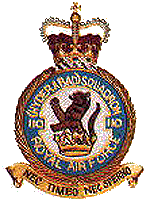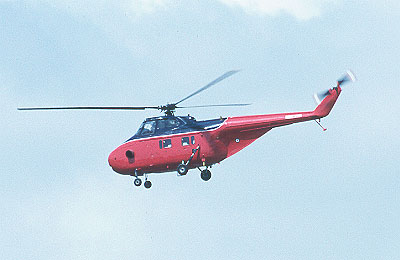Home | Airshows | The Hangar | Nostalgia | Links
Wattisham Squadrons
110 Squadron: 'Hyderabad' bound by Gary Parsons
 Born at Rendcombe in Gloucestershire on 1 November 1917,
the squadron swiftly left for Sedgeford in Norfolk with its BE2cs on the
12th. A move to Kenley in the summer of 1918 enabled the squadron to re-equip
with the more capable DH9a as a day-bomber unit, working up with the larger
machine in preparation for the Western Front by September. Although late
for the war, it survived well into 1919 based mainly at Marquise in France,
before disbandment on 27 August.
Born at Rendcombe in Gloucestershire on 1 November 1917,
the squadron swiftly left for Sedgeford in Norfolk with its BE2cs on the
12th. A move to Kenley in the summer of 1918 enabled the squadron to re-equip
with the more capable DH9a as a day-bomber unit, working up with the larger
machine in preparation for the Western Front by September. Although late
for the war, it survived well into 1919 based mainly at Marquise in France,
before disbandment on 27 August.
Reformed at Waddington on 18 May 1937, Hawker Hinds were initially issued but it was only eight months before they were traded in for the Blenheim. Later in 1937 88 Squadron was reformed from a nucleus of personnel drawn from 110 Squadron, all part of a rapid build-up seen at bomber bases the length of England in the expansion period before the war.
Arriving at Wattisham with 107 Squadron in the spring of 1939, 110 flew many missions with its sister unit, including that initial raid at Wilhelmshaven on 4 September 1939. Five Blenheims from each squadron participated, with five being lost in total, 110 faring the best with only one aircraft downed.
 Detachments were a regular part of service life during the early
war years, Ipswich being a regular dispersal with more remote travels
to places such as Lindholme in Yorkshire and Lossiemouth in Scotland.
From the latter base the squadron undertook attacks on German airfields
in Norway. Anti-shipping missions were also flown from Manston in Kent,
under Operation Channel Stop but losses were high with the demanding low-level
tactics necessary against the heavily defended supply vessels.
Detachments were a regular part of service life during the early
war years, Ipswich being a regular dispersal with more remote travels
to places such as Lindholme in Yorkshire and Lossiemouth in Scotland.
From the latter base the squadron undertook attacks on German airfields
in Norway. Anti-shipping missions were also flown from Manston in Kent,
under Operation Channel Stop but losses were high with the demanding low-level
tactics necessary against the heavily defended supply vessels.
On 17 March 1942 110 Squadron left Wattisham for India and the Far East, the unit spending the rest of the war in these parts, adopting the name 'Hyderabad'. Initially still equipped with the Blenheim, a new experience came during October when it received the American Vultee Vengeance dive-bomber for a change in tactical bombing techniques. The squadron then played a significant part in the Burma campaign, converting to the Mosquito in November 1944. It remained in theatre beyond VJ day, finally disbanding on 7 April 1946 at Labuan in Borneo.
 Surprisingly for a post-war
unit, it was re-born some three months later at Kai Tak when 96 Squadron
was renumbered as 110, equipped with Dakotas. Three main tasks were performed
by the venerable DC3; route flying between India and Japan, VIP flights
and typhoon relief work. Moving on to Changi in Singapore in July 1947,
the squadron was involved in Operation 'Firedog' during the Malayan emergency
in 1948 together with 81 and 84 Squadrons. A conversion to the Valetta
C1 followed in October 1951, the squadron providing support and communications
facilities for the Far East Force for some six more years. The last day
of 1957 brought disbandment, but not for long as on 3 June 1959 it was
once again brought to life as 155 and 194 Squadrons were combined at Kuala
Lumpur, flying the Whirlwind HAR4. The unit's main task was to resupply
forward positions and casualty evacuation. A move to Butterworth and the
more modern Sycamore HR14 came in 1960, with the Whirlwind HAR10 making
an entrance in 1963. Borneo beckoned in 1966, the squadron moving to Labuan
to assist in the withdrawal of British troops from the country. This was
achieved by 16 June 1968, so it was back to Changi where final disbandment
for the squadron came on 15 February 1971.
Surprisingly for a post-war
unit, it was re-born some three months later at Kai Tak when 96 Squadron
was renumbered as 110, equipped with Dakotas. Three main tasks were performed
by the venerable DC3; route flying between India and Japan, VIP flights
and typhoon relief work. Moving on to Changi in Singapore in July 1947,
the squadron was involved in Operation 'Firedog' during the Malayan emergency
in 1948 together with 81 and 84 Squadrons. A conversion to the Valetta
C1 followed in October 1951, the squadron providing support and communications
facilities for the Far East Force for some six more years. The last day
of 1957 brought disbandment, but not for long as on 3 June 1959 it was
once again brought to life as 155 and 194 Squadrons were combined at Kuala
Lumpur, flying the Whirlwind HAR4. The unit's main task was to resupply
forward positions and casualty evacuation. A move to Butterworth and the
more modern Sycamore HR14 came in 1960, with the Whirlwind HAR10 making
an entrance in 1963. Borneo beckoned in 1966, the squadron moving to Labuan
to assist in the withdrawal of British troops from the country. This was
achieved by 16 June 1968, so it was back to Changi where final disbandment
for the squadron came on 15 February 1971.
Home | Airshows | The Hangar | Nostalgia | Links